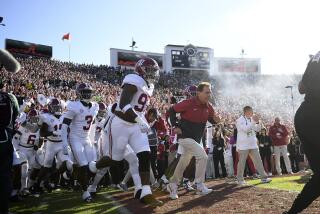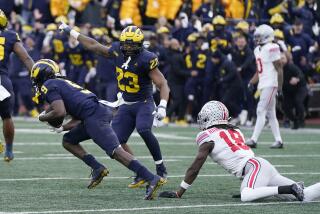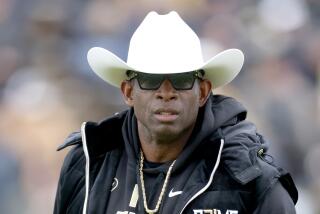Finding a little piece of history
- Share via
CAMPTONVILLE, CALIF. — Here in Gold Rush country, a land of tall trees and taller stories in the foothills of the Sierra Nevada, an elderly man walks a circular road near his home twice a day. Always, he walks with a cane. Often, he wears a red cap that says, “Ohio State, Big Ten Champion, 1950.”
The cap is in good shape. So is William Henry Harrison Dye, 91, better known as Tippy.
It has been a while since Tippy Dye has been in the news, almost 33 years since he retired as athletic director at Northwestern and headed off to Florida and the golden years with his beloved wife of 64 years, Mary.
Mary died in 2001, and Dye lives here now, with his son-in-law and daughter, Roger and Penny Carnegie, both retired.
He estimates that his move here was the 35th of his life.
“Always a step ahead of the creditors,” he says, chuckling.
He was named after William Henry Harrison, a general and hero in the War of 1812 and, preceding that, the battle of Tippecanoe against Tecumseh’s American Indian confederation. When Harrison ran for president in 1840, his running mate was John Tyler, and their campaign motto was: “Tippecanoe and Tyler too.” Thus, Tippy.
Unlike his current namesake, Harrison didn’t live into his 90s. In fact, he died of pneumonia a month after his inauguration, at 68.
Our Tippy Dye has outlived both his contemporaries and his fame.
If you are under 50, his name probably draws a blank. If you are over 50 and a knowledgeable sports fan, you are mostly amazed that he is still alive, but happy to add his name to those of John Wooden and Pete Newell, 90-plus sports legends still blessing our state.
It took some creative public relations work by Ohio State last fall to produce Dye’s public resurrection.
Before the game of the year, No. 1 Ohio State versus No. 2 Michigan on Nov. 18 at Columbus, Ohio, somebody recalled that only one Buckeyes quarterback had ever beaten archrival Michigan three consecutive times.
His name was Tippy Dye and the years were 1934, ’35 and ’36. He was 5 feet 7, 135 pounds, wore No. 50 and played offense and defense as the Buckeyes shut out the Wolverines all three years. Dye’s three straight were viewed as an especially significant feat last fall because Ohio State’s quarterback, eventual Heisman Trophy winner Troy Smith, was about to match that accomplishment. Smith did exactly that in the Buckeyes’ 42-39 victory that day, a victory that set up Monday’s national title game against Florida.
Ohio State’s public relations people even provided the network telecast with information for a graphic that told viewers that Dye was not only alive, but at the game. The game notes for the press said he was 94 and lived in Los Angeles. That was off by three years and several million people, Camptonville having a population of about 500.
Still, Ohio State had done well to recognize its past and, somehow, it became journalistically incumbent to track down this surviving nugget of gold in the hills and streams that have produced so many. Tippy Dye is a panful, a full 14 karats of history. He is from an era of sports that we know mostly through old books and old movies. Here was a chance to interview it.
He talks about one of his friends, Jesse Owens. They were page boys in the state capitol, a job given to scholarship athletes in those days.
“In his book, there is a picture of the two of us, running up the steps of the statehouse, going to work,” Dye says.
He also remembers what an incredible athlete Owens was.
“I didn’t get to see him compete much, because I was in baseball and he was in track and we were always on different fields,” Dye says. “But one time, I watched him in the Big Ten meet. He was in the 220 low hurdles and he hit the first hurdle. Must’ve flown 15-20 feet before he hit the ground. Then he got up and won the race.”
Dye wasn’t a bad athlete himself and recalled the 1934 game against Michigan as memorable for two reasons.
The sophomore Dye was hit so hard while running back a punt that his leather helmet came off and little pieces of cardboard flew out all over the field. On those little pieces of cardboard were many of the 300 plays that Coach Francis Schmidt imposed on his quarterbacks, who, in those days, called the plays.
“I was running all over the place, making sure to pick all of them up,” Dye says.
The other reason? The opposing center, Michigan’s most valuable player, was a senior named Gerald Ford.
Dye went to Ohio State as a star basketball player from Pomeroy, Ohio, mostly because the girl he was dating, his beloved Mary Russell, was heading there.
The basketball coach wanted him, but the football coaches weren’t quite as excited, especially because he had begun his high school playing days weighing only 99 pounds and had put on only 20 or so since.
So, when he went out for football in his first year, he found himself seventh-string on the freshman team. By the end of that season, he was No. 1 and destined to step up to a starting varsity role as a sophomore.
“I guess they just wanted somebody little they could knock around,” Dye says, chuckling again.
His basketball prowess -- All-Big Ten, second team All-American -- eventually led to his becoming the Buckeyes’ head coach, starting in 1947 and ending with the 1950 Big Ten title commemorated on his red cap. Dye lost in the NCAA tournament that year to City College of New York.
“We played them in Madison Square Garden, which was also their home court,” Dye says. “Stuff like that happened a lot in those days.”
Soon, he was off to the University of Washington, where he became, from 1951-’59, the third-winningest basketball coach in the school’s history, and the only coach to this day who has taken the Huskies to an NCAA Final Four.
He found one of his toughest challenges playing against that older coach down south at UCLA.
“You can’t get real close to somebody when they are playing against you,” Dye says, “especially when you played them in a bandbox [UCLA’s old gym, before Pauley Pavilion]. But John Wooden sure could coach.
“I remember one time, when I had a couple of 6-7 players, and I had them tipping the ball out to my guards if they couldn’t get the rebound. Pretty soon, Wooden figured it out and his players were standing right there.”
Dye said that often, after games, Wooden would invite him to his home.
“Hard to get mad at somebody like that, even if he’s beating you in a bandbox,” Dye says.
Sid Gillman was one of the assistant coaches when Dye played football at Ohio State. And one year, 1942, Dye was an assistant under Paul Brown.
He played in the 1937 College All-Star game at Soldier Field in Chicago, when the college kids beat the pros for the first time. Sammy Baugh of Texas Christian -- soon to be of the Washington Redskins -- threw the winning touchdown pass in a 6-0 win over the Green Bay Packers. Dye played twice against Notre Dame in games documented by Grantland Rice.
When he went into the service during World War II, he was assigned to the Navy’s V-5 pre-flight school at Chapel Hill, N.C., where he had a chance to coach a talented athlete who at Northwestern had been one of the few ever to make All-American in both basketball and football.
“Taught Otto Graham a lot about the T-formation, like Francis Schmidt had taught us at Ohio State,” Dye says.
When he was back at the Ohio State-Michigan game last fall, a man walked up to him at halftime to renew acquaintances.
“I had coached football, basketball and baseball one year at Grandview Heights High School in Columbus,” Dye says, “and John Glenn played for one of the schools we went against. It was nice to talk to him.”
When Dye went to Washington, he had decided that his eventual goal was athletic administration, and after a short stay as athletic director at Wichita State, he was hired in 1962 as the AD at Nebraska.
There, his mandate was to turn around a football program that had, for years, been embarrassingly bad, with only two winning seasons in the previous 20. Dye hired a football coach from Wyoming named Bob Devaney and, well, you know the rest.
After Nebraska, Dye had seven more seasons as athletic director, holding that position at Northwestern until 1974, when he and Mary headed for Florida.
Last fall, when his adventure took him back to Columbus, he did it on his own. Hard of hearing and not as mobile as he was, say, at 81, Dye nevertheless flew from Sacramento to Midway Airport in Chicago, changed planes there and continued on to Columbus. And he did it on Southwest Airlines, where seats are best secured by those with quickness and sharp elbows.
Roger and Mary got him down the hill to Sacramento, picked him up when he returned and made sure there would be help along the way.
But mostly, Tippy Dye got himself through to the end, just as he’d done with his football team in those three games against Michigan.
Now, this large step having been taken, there is talk about another trip or two, maybe a visit to Southern California in the spring, where Roger and Mary have some business. It would be a nice way for Dye to celebrate his 92nd birthday, April 1. Perhaps, there could even be a visit with that older coach, John Wooden, who will be 97 Oct. 14.
Given the chance, Wooden would probably arrange for lunch in a restaurant the size of a bandbox.
Bill Dwyre can be reached at bill.dwyre@latimes.com. To read previous columns by Dwyre, go to latimes.com/dwyre.
More to Read
Sign up for The Wild
We’ll help you find the best places to hike, bike and run, as well as the perfect silent spots for meditation and yoga.
You may occasionally receive promotional content from the Los Angeles Times.







